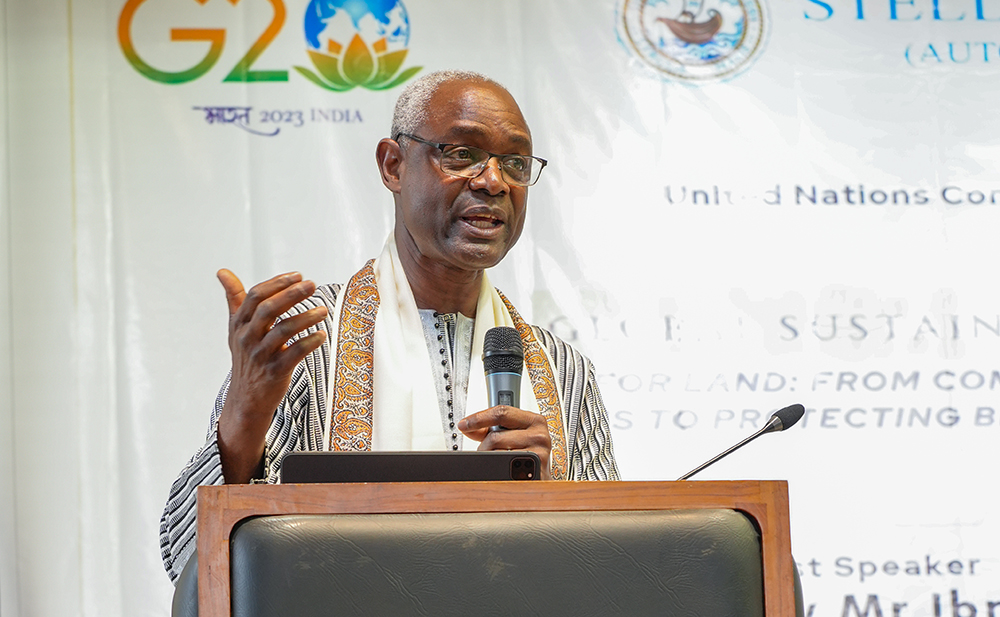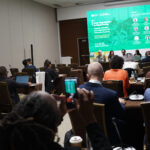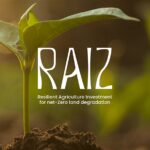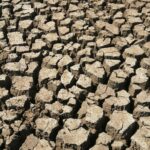Thiaw Urges Countries to Restore Land at Industrial Capacity

28 July 2023,
Chennai, India
Statement of Ibrahim Thiaw, Executive Secretary, UN Convention to Combat Desertification During the thematic session on Environment and Climate Sustainability – Land Degradation, Ecosystem Restoration, Biodiversity and Sustainable and Resilient Integrated Water Resource Management
Excellencies, ladies and gentlemen, good morning!
I am delighted to be here with you in Chennai, and for the opportunity to address G20 Ministers on two topics that are core to our mandate. Land and drought.
I am pleased to see that land use continues to be part of the G20 agenda.
Following Indonesia and Italy, the India presidency has taken important steps to move the agenda on land forward.
India’s is also deploying its national programme, as a follow up to UNCCD COP14 which it hosted in 2019.
Three years ago, during the Saudi Presidency, G20 leaders declared their ambition to reduce 50 per cent of the world’s degraded land by 2040.
The global community has pledged to restore one billion hectares of degraded land by 2030, under various international processes, from the Bonn Challenge to the Land Degradation Neutrality Target.
Close to half of these pledges – 350 million hectares – are from G20 countries.
Through the Global Biodiversity Framework, governments aim to have 30% of degraded ecosystems under restoration by 2030. These are all positive developments.
However, the current rate of land restoration is not keeping up with our ambition or commitments. The latest trends show that more land was lost than was restored.
And so, now is the time to act.
If we are to achieve the ambition of our leaders, our perspective needs to change. Land restoration should be seen as an opportunity – rather than a challenge.
Allow me to illustrate my point with a few examples:
A restoration project is being implemented in India, not far from here. In Karnataka. A Mining Corporation is set to transform the landscape of three districts that were impacted by mining. The corporation, over the next 10 years, has pledged to invest 3 billion dollars for restoration with funds from mining revenues alone.
In October 2022, India also decided to deploy social security schemes towards land restoration. Billions of dollars will be invested to increase land productivity while benefitting disadvantaged communities.
In the United States, two developments are also expected to drive the growth of the restoration industry.
The first is the National Strategy to Develop Statistics for Environmental-Economic Decisions, which will start to put environmental benefits explicitly on the balance sheet.
The second is the report on Opportunities for Accelerating Nature–Based Solutions: A Roadmap for Climate Progress, Thriving Nature, Equity and Prosperity.
These nature-based solutions involve restoring degraded land.
Promising developments in the European Union also signal a shift in favour of land restoration. The EU Commission is doing a commendable job in that respect.
In Brazil, a number of restoration projects are happening without any government subsidies. Organizations are raising money from capital markets to buy land and invest in restoration because of the lucrative returns.
I am cautiously optimistic that in the coming years, more resources (public and private) will flow towards land restoration. The main challenge is the scale of restoration projects are small, relative to the scale of the problem.
To restore one billion hectares of degraded land in the next decade, we will need to grow restoration enterprises at an industrial capacity.
While enhancing our support to communities and NGOs to continue restoration efforts is indispensable, we will also need to develop capacity for large scale restoration.
This is a huge opportunity for G20 Member States.
G20 members already have large scale enterprises in agriculture, mining and engineering.
These firms are uniquely positioned to leverage their industry expertise into a sustainable future.
Corporations can – and indeed should – develop a new vertical on restoration.
For their own sake. And for the planet.
G20 members have a thriving entrepreneurial culture.
They have developed capital and financial markets that can support the evolution of a new and global land restoration industry.
Land restoration can create millions of jobs at the cornerstone of the latest innovations.
Restoring degraded land is arguably one of the cheapest solutions to climate change.
Restoring land means nurturing soil, biodiversity and ecosystems back to health. Giving millions access to productive land for agriculture, commerce, recreation and sustenance.
Investing in sustainable land management is investing in eco-tourism, water conservation, and drought resilience.
Reversing land loss means reducing the irregular migration of people and conflicts over resource scarcity.
In other words, we urge G20 countries to seek coherence and complementarity. Climate change, biodiversity loss, drought and land loss are clearly interconnected.
We need consistency. There is no dichotomy between nature and climate. There should be no duplication; neither in policy nor in finance.
Recent reports on the future of employment from the World Economic Forum, McKinsey, and others, suggest that Artificial Intelligence may destroy many jobs. But the environment sector is set to thrive.
And who is better prepared than G20 members to up-skill its workforce for an emerging restoration industry?
Excellencies,
Before I conclude, let me say a few words on drought, the second big mandate of the UNCCD.
For years, drought was considered an issue of some regions in the developing world. Today, there is hardly a G20 country that is spared of its effects.
Droughts are disrupting energy and food production around the world.
Meanwhile, large cities are rationing water in South Africa, Mexico, the United States and Europe.
In and amongst this, wildfires continue to ravage communities –at times becoming unstoppable. And to various parts of the world, heatwaves are becoming ‘the new normal’.
According to the World Meteorological Organization, droughts are the world’s costliest and deadliest natural disaster.
A new International Drought Resilience Alliance (IDRA) established under the co-presidencies of Spain and Senegal.
It aims at leading a paradigm shift in drought management – from a reactive to proactive action that better prepares countries and communities for future droughts.
Managing land properly and building resilience to drought are fundamental components to a decent life.
Finally, I want to flag that the next Conference of the Parties to the UNCCD, COP16 takes place in December 2024 in Riyadh, Saudi Arabia.
This will be a landmark COP where World Leaders, Ministers, CEO and Society are expected to make critical decisions on Land and Drought.
The world is transforming rapidly. It will be an unforgiving mistake to lose sight of our land and its wellbeing. It serves as a reminder of how we got here, and the future we are all fighting for.
I thank you for your attention.




